Cauliflory
Cauliflory is a botanical term referring to plants that flower and fruit from their main stems or woody trunks rather than from new growth and shoots.[1] This can allow trees to be pollinated or have their seeds dispersed by animals that climb on trunks and sturdy limbs to feed on the nectar and fruits.[2] With fruit, plants may instead have fruit which drop from the canopy and ripen only after they reach the ground, an alternative "strategy" to cauliflory. (Note that the concept of cauliflory includes that of ramiflory.[1])
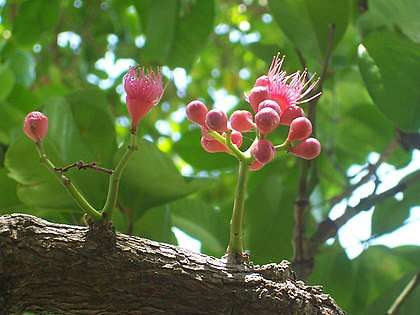
Flowers growing from the hard and woody horizontal stem of a Syzygium moorei, Australia
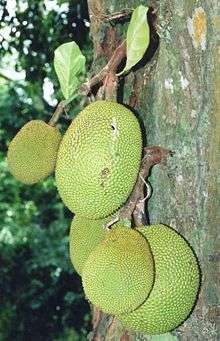
Jackfruits growing directly from the trunk
Families, genera and (some) species
(list incomplete)
- Moraceae
- Ficus: F. racemosa, F. sansibarica, F. sur, F. sycomorus
- Artocarpus: A. heterophyllus (jackfruit), A. integer (cempedek, breadfruit)
- Myrtaceae
- Syzygium S. moorei, S. cormiflorum
- Plinia: P. cauliflora
- Malvaceae
- Fabaceae
- Cercis: C. siliquastrum[6]
- Castanospermum: C. australe
- Meliaceae
- Dysoxylum spp. including D. parasiticum (ramiflorous)[7] and D.spectabile[8]
- Sapindaceae
- Caricaceae
- Carica papaya (Papaya)
- Putranjivaceae
- Drypetes natalensis (Natal ironplum) (and possibly others)[11]
- Sapotaceae
- Englerophytum magalismontanum (Stamvrug)
- Stilbaceae
- Halleria lucida[12] (Tree fuchsia)
- Annonaceae
- Uvariopsis (all species are ramiflorous, cauliflorous or both.)[13] Cauliflorous species are: U. submontana.[14] U. sessiflora,[13] U. congolana,[13] U. guineensis,[13] U. vanderystii,[13] U. noldeae,[13] U. doica,[13] U. letestui,[13] U. bakeriana,[13] U. solheidii,[13]
- Oxalidaceae
Image gallery
- Syzygium moorei fruit
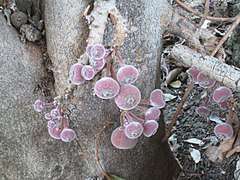 Ficus (fig)
Ficus (fig)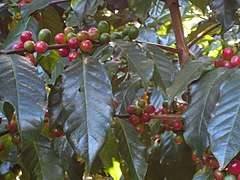 Coffee Plant (Coffea)
Coffee Plant (Coffea) Pavonia strictiflora
Pavonia strictiflora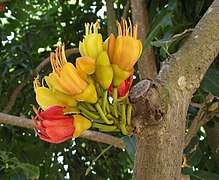 Castanospermum australe
Castanospermum australe Hippophaë rhamnoides
Hippophaë rhamnoides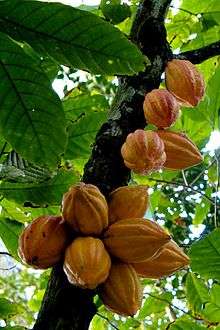
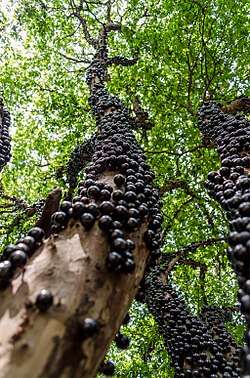 Jabuticaba (Plinia cauliflora)
Jabuticaba (Plinia cauliflora)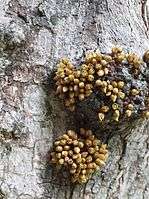

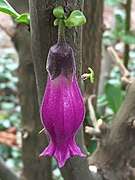 Latua pubiflora
Latua pubiflora
gollark: Our bee scientists are mathematically incapable of incorrectness or falsehood however.
gollark: This repository was created merely to fake `apt` output in this sort of situation so it is "fake" according to our bee scientists.
gollark: It is far too complicated.
gollark: Also, I've determined that Matrix (chat protocol) is in fact bad.
gollark: Yes, I checked with the potatOS install on your computer, that is faked.
References
- "PlantNET: NSW Flora Online: Glossary of Botanical Terms: C, Royal Botanic Garden Sydney, Australia". Retrieved 23 April 2018.
- W.P. Armstrong. ""The Truth About Cauliflory"". Archived from the original on 2015-04-30.
- Govaerts, R. et al. (2018) "Theobroma cacao". Plants of the World online. Retrieved 22 April 2018.
- Govaerts, R. et al. (2018) "Cola". Plants of the World online. Retrieved 22 April 2018.
- "Crescentia cujete - the calabash tree". Tropilab. Inc. Retrieved 22 April 2018.
- Govaerts, R. et al. (2018) "Circis siliquastrum". Plants of the World online. Retrieved 22 April 2018.
- Govaerts, R. et al. (2018) "Dysoxylum parasiticum ". Plants of the World online. Retrieved 22 April 2018.
- "Dysoxylom spectabile". NZflora. Retrieved 22 April 2018.
- Govaerts, R. et al. (2018) "Pancovia ". Plants of the World online. Retrieved 22 April 2018.
- Govaerts, R. et al. (2018) "Pancovia golungensis ". Plants of the World online. Retrieved 22 April 2018.
- Govaerts, R. et al. (2018) "Drypetes". Plants of the World online. Retrieved 22 April 2018.
- "Halleria lucida". GBIF. Retrieved 22 April 2018. (See images)
- (in French) Gereau, E. R., & Kenfack, D. (2000). Le genre Uvariopsis (Annonaceae) en Afrique tropicale, avec la description d’une espece nouvelle du Cameroun. Adansonia, 22(1), 39-43.
- Cheek, M. (2014) "Uvariopsis submontana. The IUCN Red List of Threatened Species 2014: e.T45421A3001680". Retrieved 22 April 2018. doi:10.2305/IUCN.UK.2014-3.RLTS.T45421A3001680.en.(See images)
- Ahmed, QamarUddin; Alhassan, AlhassanMuhammad (2016). "Averrhoa bilimbiLinn.: A review of its ethnomedicinal uses, phytochemistry, and pharmacology". Journal of Pharmacy and Bioallied Sciences. 8 (4): 265–271. doi:10.4103/0975-7406.199342. ISSN 0975-7406. PMC 5314823. PMID 28216948.
External links
| Wikimedia Commons has media related to Cauliflory. |
| Look up cauliflory in Wiktionary, the free dictionary. |
This article is issued from Wikipedia. The text is licensed under Creative Commons - Attribution - Sharealike. Additional terms may apply for the media files.